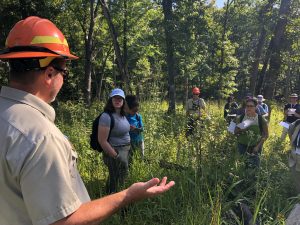Hoosier National Forest Field Trip at ESA 2019 Annual Meeting
ESA’s Vegetation Panel helped kick off the 2019 Annual Meeting with a fun field trip on the Sunday before the major events of the week began. ESA’s Annual Meeting ran from August 11-16 in Louisville, Kentucky and attracted ecologists from all over the world. ESA’s Vegetation Classification Panel ran the field trip to The Hoosier National Forest in Southern Indiana visiting the Tell City Barrens, Buzzard Roost, and Hemlock Cliffs. The Hoosier National Forest is scattered across nine counties in south-central Indiana and comprises about half of the state’s public forest land. Established in 1891, this forest is home to 200,000 acres of openland and forest, containing a wide variety of wildlife habitat and rare plants (usda.gov). Only about 50 miles west of Louisville, participants endured just a short ride to enjoy fun recreational trails perfect for observing interesting plant communities and wildlife.

Tiger swallowtail on Helianthus with big bluestem and Coreopsis. Boone Creek, Hoosier National Forest
During the field trip members of ESA’s Vegetation Panel taught participants about the U.S. National Vegetation Classification (USNVC) and its application in the field. Learning about the USNVC was quite befitting to the conference’s theme, the USNVC is a dynamic classification that thrives on diversity and inclusion. The more plant ecologists that use and contribute to the classification, the stronger a tool it becomes. The USNVC ensures that vegetation ecologists from across the country can communicate in a common ‘language’ about the plant communities they work with. This allows ecologists to work with each other, managers, and the public, more easily; allowing them to track change and identify communities of concern with greater efficiency.
During the field trip participants also learned about the management priorities of The Hoosier National Forest both historically and presently. One of the many current management activities involved restoring the globally rare post oak (Quercus stellata) and blackjack oak (Q. marlandica) barrens, and Central Limestone Glade communities. At Buzzard Roost the group hiked through mesified oak-hickory forest and enjoyed a spectacular vista of the Ohio River. To end the trip, the interesting topography of the box canyon, Hemlock Cliffs, provided equally interesting ecological features. Unique plant communities of the mesic understory, and the Eastern Hemlock – Tuliptree Forest Alliance with one of the southern disjunct populations of Eastern hemlock (Tsuga canadensis). The day was full of flora and fauna identification, learning, and nature, a great way to begin Annual Meeting! We hope participants learned something new, and if they don’t do so already, will embrace the use of the USNVC in their work.
Learn more about the Forest:
“Forest Facts.” Hoosier National Forest – About the Forest, United States Department of Agriculture, https://www.fs.usda.gov/detail/hoosier/about-forest/?cid=FSEPRD647584.

